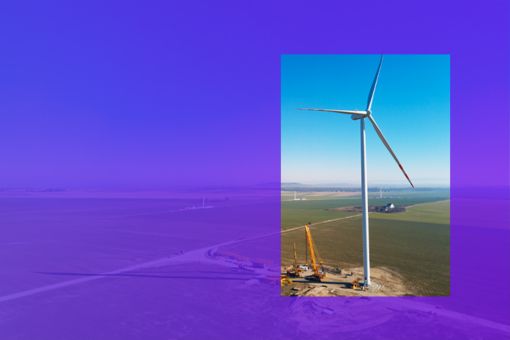The sustainable transformation of the German economy is essential to ensure the country's competitiveness. The focus of this transformation is decarbonisation, which is being driven forward by the German government with ambitious targets. The goal: increased resilience.
The accelerated expansion of photovoltaics (PV) plays a central role in this transformation. A complex task that opens up new design and growth options.
Photovoltaics in Germany: The status quo
The most recent amendment to the Renewable Energy Sources Act (EEG) set four main objectives:
- The share of renewable energies in electricity consumption is to be increased to at least 80 per cent by 2030.
- The aim is to achieve almost greenhouse gas-neutral operations by 2035.
- Global warming is to be limited to 1.5 degrees.
- Dependence on fossil fuels is to be reduced.
Various measures have been implemented to achieve this, including
- More expansion opportunities for solar energy
- Higher subsidies for solar systems
- Abolition of the EEG levy and better utilisation of market opportunities
- Support programmes for battery storage systems
- Greater promotion of energy communities
The expansion plans
In the Federal Solar PV Strategy (May 2023, Section 4 EEG), the national expansion target was set at 215 GWp of installed capacity in 2030 and a PV share of 30 per cent of total electricity production.
Annual targets can also be derived from the federal government's plans, which illustrate the growth pattern:
- The coming years will be characterised by strong, double-digit growth in photovoltaics. The annual increase in capacity is set to rise to over 22 GWp/a from 2026. By way of comparison, a record 14 GWp of new capacity was added in 2023.
- The period between 2026 and 2040 is planned as a phase of sustained growth with annual additions at a high level of approx. 18 to 22 GWp/a. The annual growth rate during this period is eight per cent.
- The expansion also includes the replacement of old PV systems ("repowering"), which is currently still marginal, but could amount to up to 15 GWp/a in the phase after 2040.
Market development
Looking at the historical market development, two growth phases of photovoltaics in Germany can be distinguished.
The first growth phase for photovoltaics was primarily based on subsidy mechanisms.
It began in the 2000s and lasted until 2012, when the EEG amendment provided for a reduction in the feed-in tariff from 18.8 to 11.8 ct/kWh, including further degression. With generation costs still high, this led to a standstill in the market and a sharp levelling off of annual expansion. With the now reduced subsidies, demand for modules also declined overall. It increasingly shifted in favour of cheaper modules from China, which led to numerous insolvencies of established equipment manufacturers in the industry.
The second growth phase, which began in 2017, was and continues to be driven by sustainable growth.
There are three main reasons for this:
Photovoltaics is one of the most favourable technologies for generating electricity. On average, electricity generation costs have fallen from 16.5 ct/kWh in 2010 to 4.4 ct/kWh in 2021 - a reduction of around 80 per cent.
The favourable generation costs make it possible to realise large projects with little or no subsidy and to sell the electricity to customers via long-term power purchase agreements. This opens up an important new sales channel for energy producers and, depending on the structure of the PPA, gives them direct access to end consumers.
In light of the energy crisis in 2021 and regulatory drivers such as increased requirements due to the implementation of the EU Sustainability Reporting Directive (CSRD), the demand for green electricity on the market has also increased significantly. In order to achieve the decarbonisation targets that have been set, a transformation on the procurement side can increasingly be observed: The focus is shifting from traditional certificates of origin to physical PPAs.
The 2021 and 2023 amendments to the Renewable Energy Sources Act (EEG) added new targets, which firstly designated new privileged areas and secondly significantly increased the volume of tenders issued by the Federal Network Agency.
The positive momentum and the growing interest of companies and investors is very clear when you look at the latest tender results from 1 December 2023. A volume of around 1.6 GWp was put out to tender for the promotion of new ground-mounted PV systems. This resulted in 5.5 GWp of bids - an almost threefold oversubscription.
Conclusion and Outlook
It can be stated that the market for PV investments will continue to gain momentum in the coming years, driven by energy policy and supported by attractive subsidies and tenders from the Federal Network Agency.
At the same time, the increasing market attractiveness is leading to greater competition. More and more companies are tapping into the market and competing for the limited resources, ground-mounted PV installations and systems.
Domestic and foreign investors, energy producers and energy-intensive companies should therefore set the right course now, analyse their own portfolio and examine strategic investments. In order to survive the growing competition for attractive sites and personnel, developers and energy producers should also consider strategic co-operations such as joint ventures and co-development agreements.
Comprehensive advice from KPMG
The current developments offer great opportunities for companies. Our experts will support you with their specialist knowledge and industry experience so that you can utilise these opportunities.
Our focus for your success
- We support you in the development of market entry strategies and work with you to identify gaps in the market and potential growth opportunities.
- We use market analyses to identify potential target companies and thus enable more efficient decision-making for managers.
- We actively support you in the realisation of M&A transactions and co-development agreements.
- We help you comply with regulatory requirements and provide comprehensive advice on decarbonising your energy supply.
- We advise you holistically: Thanks to our expertise in the areas of legal*, tax, financial due diligence and commercial due diligence, we can support you in carrying out due diligence audits. This enables us to minimise risks in M&A transactions and cooperations.
Talk to us.
*Legal services are provided by our co-operation partner KPMG Law.
Further interesting Insights for you
Your contact persons
Keywan Ghane
Partner, Performance & Strategy
KPMG AG Wirtschaftsprüfungsgesellschaft
Robert Schwarz
Senior Manager, Performance & Strategy, Enterprise Performance
KPMG AG Wirtschaftsprüfungsgesellschaft
Connect with us
- Find office locations kpmg.findOfficeLocations
- kpmg.emailUs
- Social media @ KPMG kpmg.socialMedia





